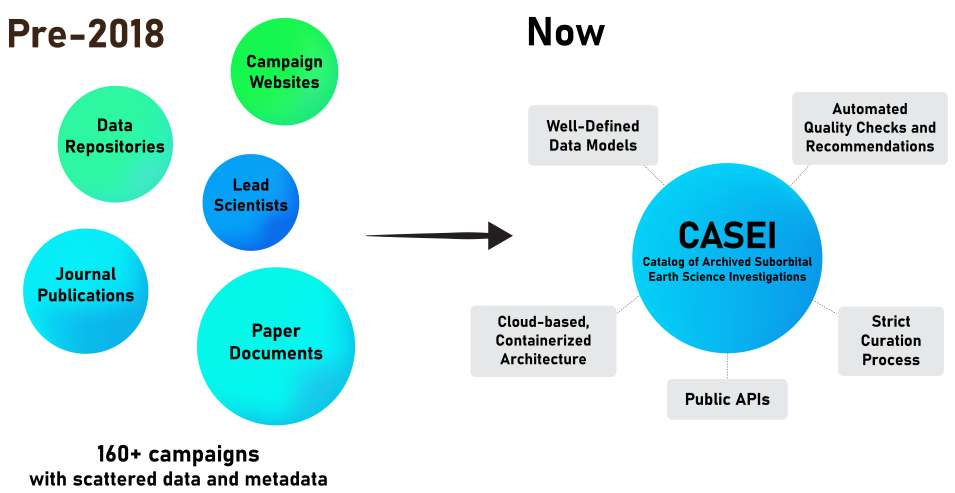The ADMG team has taken care to not only focus on recent campaigns but also to curate information about historical campaigns from up to 50 years ago. For example, the NASA-led First International Satellite Cloud Climatology Project (ISCCP) Regional Experiment (FIRE) conducted five deployments with more than 240 flights from 1986 to 1998. The FIRE campaign focused primarily on gathering measurements of marine stratocumulus and cirrus cloud systems to help determine their role in global climate events. Airborne remote and in situ sensor data combined with ground-based, balloon, shipborne, and satellite cloud observations produced a robust collection of more than 120 data products. By entering search parameters in CASEI, researchers today can quickly gain access to historical data and information from campaigns such as FIRE to explore long-term variability in atmospheric phenomena. The data products from FIRE are archived at NASA’s Atmospheric Science Data Center (ASDC), the DAAC focused on atmospheric science data products and services.
Opening Science Access
It’s fitting that the full release of CASEI is occurring in 2023, as it highlights one of NASA’s top priorities. NASA, along with the White House and other federal agencies, declared 2023 A Year of Open Science as part of a broad effort to shift the paradigm for science data access and use. The ADMG team’s efforts directly support NASA’s goal to foster more “inclusive, transparent, and collaborative scientific processes.”
Wingo observes that CASEI plays a major role in NASA’s Open-Source Science Initiative (OSSI). “ADMG and CASEI are supporting open science by providing an efficient, intuitive means for the discovery of, contextualization for, and access to suborbital Earth science data,” she says. “This further supports the appropriate reuse of data, increasing the return on investments made for data collection and stewardship.”
Deborah Smith, a principal research scientist at The University of Alabama in Huntsville and the original project leader of ADMG, agrees that CASEI is adding considerable value to airborne data management and research practices. “CASEI helps to open the history of airborne and field activities and details of each activity to all users,” she says. “Paired with the data rescue efforts of ADMG, the data are slowly becoming open to all. I am always happy when I hear a scientist say that what we are doing is highly valuable and much appreciated.”
Enhancing CASEI
While the ADMG team is celebrating the full release milestone, they won’t be stepping away from their keyboards any time soon. They still have dozens of campaigns to curate and add to the CASEI interface as well as a long wish list of user interface enhancements to implement to create an even more efficient and intuitive user experience.
Several updates are in development that will be added to CASEI later this year and beyond:
- Maps of platform tracks and locations (flight paths, ship voyages, field sites) for all campaigns in the CASEI inventory
- Increased transparency in curation status: posts on what campaigns, instruments, and platforms are currently being curated and coming soon to the CASEI database
- Support for determining coincident satellite overpasses
- Additional links to resources on campaign- or data-specific tools and software as well as historical perspectives on the origin of individual platforms and their use in NASA Earth science
Looking to the Future
As CASEI continues to improve, ADMG and NASA’s ESDS Program are exploring long-term solutions to support these unique metadata and discovery capabilities. Currently, a collaborative team consisting of ADMG, DAAC, and NASA Earth Science Data and Information System (ESDIS) Project personnel are planning what will become the Airborne and Field Data Resource Center—a virtually operating resource that centralizes essential information and access to tools, software, and data. Once the Center is operational, CASEI will be a cornerstone of its offerings.
For now, CASEI will continue to be administered by ADMG, and the team will continue their mission to support airborne and field science research through effective data stewardship.



